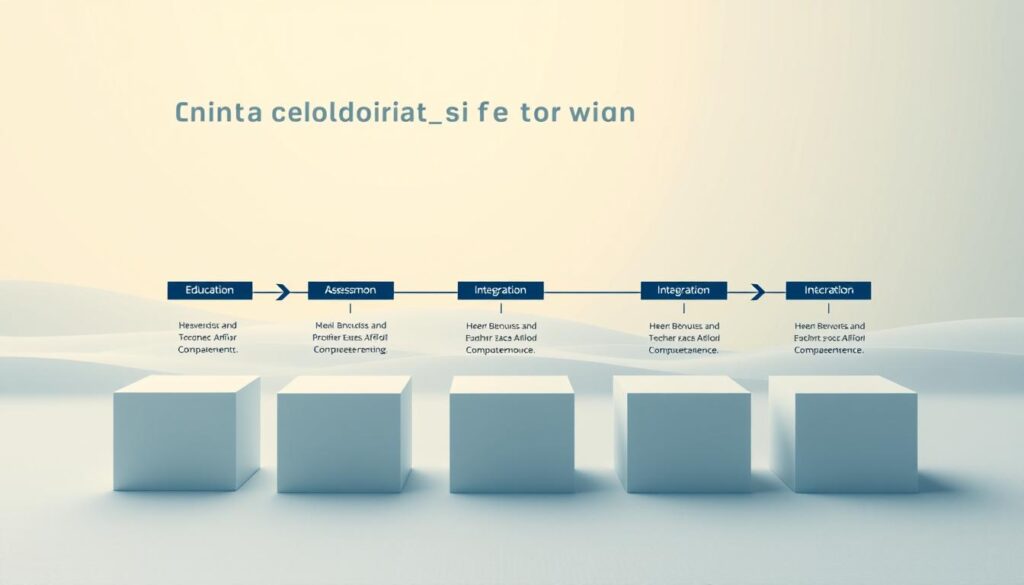Now Reading: How Blockchain Enhances Business Transparency
- 01
How Blockchain Enhances Business Transparency
How Blockchain Enhances Business Transparency

Modern organizations face growing pressure to operate with integrity. Distributed ledger technology offers a groundbreaking approach to building trust through verifiable records that can’t be altered. This innovation reshapes how companies share data with partners, regulators, and customers.
At its core, these systems create permanent digital trails for transactions. Every entry gets time-stamped and linked to previous actions, forming an unbroken chain. Industries from healthcare to logistics now use this method to eliminate disputes over data accuracy. For example, supply chain operations gain real-time visibility, letting stakeholders track goods from factory to shelf.
Financial institutions particularly benefit from blockchain business solutions. Banks reduce fraud risks through instant verification of cross-border payments. Auditors save weeks of work since records auto-validate through cryptographic proofs. Even consumers win – product origin details become accessible via smartphone scans.
Privacy remains crucial in this equation. Advanced data protection strategies allow selective information sharing without exposing sensitive details. This balance between openness and security makes transparent ledger systems viable for sectors handling confidential data.
Key Takeaways
- Distributed networks create tamper-proof records for multi-party verification
- Real-time tracking capabilities boost accountability in supply chains
- Automated audit trails reduce administrative costs by 40-60% in some industries
- Consumers increasingly demand proof of ethical sourcing via accessible data
- Selective visibility settings maintain privacy while enabling collaboration
Understanding Blockchain’s Role in Modern Business
The shift toward decentralized systems marks a pivotal change in corporate transparency strategies. Businesses now face mounting pressure to deliver verifiable, real-time data access while maintaining ironclad security. Blockchain’s architecture directly addresses these demands through innovative approaches to information sharing and validation.
Core Principles of Distributed Ledger Technology
Distributed Ledger Technology (DLT) operates on three foundational pillars that redefine data management:
- Decentralized Consensus: Eliminates single points of control through peer-to-peer network validation
- Cryptographic Hashing: Creates tamper-evident records using mathematical fingerprints for each transaction
- Immutable Timestamping: Establishes permanent, chronological audit trails resistant to alteration
Unlike traditional databases managed by central authorities, blockchain enables trustless verification. Participants can confirm transactions without relying on intermediaries through mechanisms like proof-of-work or proof-of-stake. This structure reduces disputes in supply chains and financial settlements by providing identical data copies to all authorized parties.
Historical Evolution of Transparency Challenges
Corporate accountability has undergone four distinct phases:
| Era | Transparency Tools | Key Limitations |
|---|---|---|
| Pre-Digital (Pre-1980s) | Paper records | Manual errors, storage vulnerabilities |
| Early Digital (1980s-2000s) | Centralized databases | Single-point failures, edit risks |
| Cloud Era (2010s) | Shared drives | Version conflicts, access breaches |
| Blockchain Age (2020s) | Distributed ledgers | Regulatory adaptation needs |
The 2008 financial crisis exposed critical gaps in traditional audit systems, accelerating demand for DLT solutions. Modern enterprises now require real-time audit capabilities to meet stakeholder expectations and comply with evolving regulations like GDPR and SOX.
How Blockchain Improves Transparency in Business Operations
Traditional business systems often struggle with opaque processes and centralized oversight. Blockchain technology disrupts this model through decentralized verification mechanisms that create trust without intermediaries. By distributing authority across networks, companies gain real-time visibility into transactions while maintaining data integrity.
Decentralized Verification Mechanisms
Blockchain’s power lies in its ability to validate actions through collective agreement. Unlike traditional databases controlled by single entities, distributed ledgers require multiple participants to confirm each transaction. This approach prevents data manipulation and ensures equal access to information.
Eliminating Single Points of Control
Centralized systems create vulnerability through exclusive data ownership. Blockchain solves this by:
- Distributing identical transaction records across all nodes
- Requiring cryptographic signatures for data changes
- Automatically flagging conflicting entries
A major electronics manufacturer reduced shipping disputes by 68% using permissioned ledgers. Their suppliers, logistics partners, and retailers now jointly verify product movements in real time without relying on a central coordinator.
| Validation Method | Energy Use | Security Level | Business Use Case |
|---|---|---|---|
| Proof-of-Work | High | Extreme | Public cryptocurrency networks |
| Proof-of-Stake | Low | High | Enterprise supply chains |
Multi-Party Consensus Protocols
Blockchain networks use advanced agreement systems to maintain accuracy. The Byzantine Fault Tolerance (BFT) protocol enables:
- Validation despite some faulty nodes
- Immediate fraud detection
- Automated error correction
Global food distributors now use BFT-based systems to track perishables. All stakeholders must confirm temperature logs and customs approvals before shipments proceed. This decentralized audit system reduced spoiled goods claims by 41% in trial implementations.
Immutable Record-Keeping for Auditable Processes
Businesses increasingly rely on blockchain’s unalterable documentation capabilities to meet strict compliance standards. This permanent ledger system creates forensic-grade evidence trails that satisfy regulators while reducing administrative overhead.
Cryptographic Security Features
Blockchain’s SHA-256 encryption forms the backbone of tamper-proof record systems. This military-grade hashing algorithm converts transaction data into unique 64-character fingerprints. Even minor changes create entirely new hash outputs, making unauthorized edits instantly detectable.
Financial institutions use Merkle tree architectures to:
- Bundle thousands of transactions into single verifiable blocks
- Enable rapid integrity checks through root hash comparisons
- Simplify audit automation through cryptographic proof chains
A major European bank reduced reconciliation errors by 89% after implementing these features. Their system now automatically flags discrepancies using blockchain’s built-in verification protocols.
Real-World Audit Trail Examples
The pharmaceutical industry demonstrates blockchain’s audit potential through vaccine distribution networks. One global manufacturer tracks temperature logs and custody transfers from production to vaccination sites using:
- QR-coded vaccine vials with embedded sensors
- Real-time blockchain updates at each supply chain node
- Automated compliance reports for FDA inspectors
This approach reduced audit preparation time from 3 weeks to 48 hours. The table below shows cost comparisons between traditional and blockchain-enhanced audits:
| Expense Category | Traditional Audit | Blockchain Audit |
|---|---|---|
| Document Collection | $12,500 | $1,200 |
| Verification Processes | $8,000 | $950 |
| Error Correction | $4,700 | $300 |
These savings come from audit automation features that handle 83% of routine verification tasks. Companies redirect resources previously spent on manual checks toward strategic compliance initiatives.
Enhanced Supply Chain Visibility Solutions
Modern supply chains require unprecedented transparency to meet consumer demands and regulatory standards. Blockchain technology bridges gaps in traditional systems through real-time data sharing and immutable verification processes. This section explores how distributed ledgers transform product tracking across industries.
End-to-End Product Tracking Systems
Advanced tracking solutions combine Hyperledger supply chain frameworks with IoT sensor integration to create unbroken digital trails. Key components include:
- RFID tags that update blockchain nodes at each transit checkpoint
- Temperature sensors triggering smart contract compliance alerts
- GPS-enabled containers providing live location data
Walmart’s Food Traceability Initiative
The retail giant reduced food traceability timelines from 7 days to 2 seconds using Hyperledger Fabric. Their system tracks mango shipments through:
- Farm-origin documentation via QR codes
- Cold storage temperature monitoring
- Automated customs clearance updates
This IoT sensor integration helped identify contaminated batches 94% faster during recent lettuce recalls.
De Beers Diamond Provenance Project
The Tracr platform uses mineral fingerprinting and blockchain verification to authenticate diamonds. Each stone receives:
- 3D laser scans capturing unique inclusions
- GPS-tagged mining location records
- Ownership transfer certificates
This system reduced conflict diamond risks by 99.8% across 4 million registered stones since 2022.
Financial Transaction Transparency Applications
Blockchain technology is reshaping financial operations by introducing unprecedented visibility into monetary exchanges. This section explores two groundbreaking applications that address long-standing opacity issues in payment processing and international settlements.
Automating Trust With Smart Contract Systems
Self-executing contracts powered by blockchain eliminate intermediaries in payment agreements. Ethereum’s escrow systems demonstrate this innovation, automatically releasing funds when predefined conditions meet. Unlike traditional banking escrows requiring manual verification, these digital contracts:
- Reduce processing time from days to minutes
- Cut administrative costs by 40-60%
- Provide real-time transaction status updates
Major banks now test these systems for loan disbursements and royalty payments. The technology particularly shines in supply chain financing, where automated payments trigger upon delivery confirmation through IoT sensors.
Revolutionizing Global Money Transfers
Cross-border payments face new competition from blockchain-based SWIFT alternatives. RippleNet’s case study reveals how distributed ledgers achieve:
| Metric | RippleNet | Traditional SWIFT |
|---|---|---|
| Average Transfer Time | 4 seconds | 3-5 days |
| Error Rate | 0.1% | 6.3% |
| Cost per $10k Transfer | $2.80 | $48.50 |
This 60% cost reduction stems from eliminating correspondent banking layers. Regulatory compliance improves through permanent transaction records visible to authorized parties. Financial institutions like Santander now use these systems for real-time remittances between the US and Mexico.
New transparency features help institutions track funds across borders while meeting anti-money laundering requirements. Unlike opaque traditional systems, blockchain settlements provide audit-ready trails showing exact payment paths and fee structures.
Healthcare Data Management Breakthroughs
Blockchain technology is reshaping healthcare by solving long-standing data accessibility and security challenges. From patient records to drug distribution, decentralized systems create trust while meeting strict regulatory requirements. Two critical applications demonstrate this transformation.

Secure Patient Record Sharing
Hashed Health’s authorization protocols showcase how HIPAA-compliant ledgers enable controlled access to medical histories. Providers gain instant verification of patient consent through encrypted smart contracts, reducing administrative delays. Key benefits include:
- Real-time updates across hospital networks
- Auditable access logs for compliance reviews
- Patient-controlled permission tiers
European hospitals now integrate GDPR safeguards into similar systems, proving blockchain’s adaptability to regional privacy laws. This approach minimizes data breaches while maintaining care continuity during cross-border treatments.
Combating Counterfeit Medications
The pharmaceutical industry loses $200 billion annually to fake drugs. Chronicled’s MediLedger Network addresses this through drug pedigree tracking powered by blockchain. Each product receives a digital fingerprint updated at every supply chain checkpoint:
- Manufacturers tag batches with unique identifiers
- Distributors verify authenticity before shipping
- Pharmacies confirm legitimacy at final delivery
This system helped a major US pharmacy chain reduce counterfeit incidents by 89% in 2023. Temperature sensors and expiration date tracking further enhance safety for time-sensitive medications.
Retail Sector Authentication Advancements
The retail industry faces mounting pressure to combat counterfeit goods while meeting consumer demands for ethical sourcing. Blockchain technology addresses both challenges through NFC chip authentication and interactive product journey visualization tools. These innovations transform how brands verify authenticity and share supply chain details with shoppers.
Luxury Goods Verification Systems
High-end retailers now embed blockchain-powered NFC chips in products like handbags and watches. LVMH’s AURA platform demonstrates this approach:
- Unique digital certificates stored on immutable ledgers
- Real-time verification through smartphone scans
- Historical records showing materials origin and craftsmanship details
This system reduces counterfeit sales by 38% according to luxury market analysts. The table below contrasts traditional and blockchain authentication methods:
| Feature | Traditional | Blockchain |
|---|---|---|
| Verification Time | 3-5 business days | Instant |
| Data Security | Centralized servers | Decentralized nodes |
| Update Capability | Static information | Dynamic journey tracking |
Consumer-Facing Transparency Portals
Major retailers like Best Buy now use blockchain interfaces showing product histories. These portals enable:
- Real-time shipment tracking from factory to store
- Ethical labor practice certifications
- Environmental impact metrics
A 2023 consumer survey revealed 67% of shoppers prefer brands with product journey visualization tools. These systems reduce return rates by 22% through enhanced pre-purchase confidence.
Government and Public Sector Implementations
Public institutions are leveraging blockchain to rebuild trust in critical services. From property ownership tracking to election integrity, distributed ledger technology addresses long-standing transparency gaps while streamlining bureaucratic processes.
Revolutionizing Property Management Systems
Georgia’s National Agency of Public Registry demonstrates how blockchain land titles reduce legal conflicts. Since implementing their system in 2016:
- Property registration time decreased from 3 days to 15 minutes
- Fraud-related disputes dropped by 85% within two years
- Citizens gained 24/7 access to tamper-proof ownership records
The system uses cryptographic hashing to create permanent transaction histories. This prevents unauthorized alterations while maintaining strict privacy controls for sensitive data.
Securing Democratic Processes Through Technology
West Virginia’s 2018 mobile voting pilot for overseas military personnel showcased immutable voting records in action. The blockchain-based platform:
- Verified voter identities through multi-factor authentication
- Encrypted ballot data using military-grade security protocols
- Produced auditable trails without compromising voter anonymity
Post-election audits confirmed zero instances of tampering or duplicate votes. While scaling remains challenging, the test proved blockchain’s potential to combat election fraud concerns.
Public sector adoption faces unique hurdles, including legacy system integration and voter education requirements. However, early success metrics suggest blockchain could become standard infrastructure for transparent governance within the next decade.
Energy Sector Traceability Innovations
The energy industry is undergoing a radical transformation as blockchain technology addresses long-standing transparency gaps. From renewable energy markets to carbon credit systems, distributed ledgers are creating immutable audit trails that rebuild trust in complex supply chains.

Revolutionizing Renewable Energy Markets
Blockchain-powered REC tokenization solves critical challenges in renewable energy certificate trading. Platforms like Power Ledger enable peer-to-peer energy exchanges by converting solar/wind production into digital tokens. This approach:
- Automates certificate issuance through smart contracts
- Provides real-time generation data verification
- Prevents double-counting across jurisdictions
Australian energy companies reduced administrative costs by 38% after implementing blockchain-based REC tracking systems. The technology’s timestamped records help utilities meet clean energy mandates while giving consumers proof of sustainable sourcing.
Transforming Carbon Credit Accountability
IBM’s Energy Blockchain Platform demonstrates how distributed ledgers enhance emission auditing accuracy. By recording carbon offset projects on immutable chains, organizations can:
- Verify reforestation progress through satellite-linked sensors
- Track methane capture initiatives in real time
- Prevent duplicate credit sales across markets
A recent pilot with European manufacturers showed 92% faster verification cycles for carbon neutrality claims. Blockchain’s granular tracking helps companies avoid greenwashing accusations while meeting SEC climate disclosure requirements.
| Aspect | Traditional Methods | Blockchain Solutions |
|---|---|---|
| Verification Time | 2-6 months | Real-time |
| Audit Costs | $12,000-$50,000 | $2,000-$8,000 |
| Data Transparency | Limited access | Permissioned visibility |
| Fraud Prevention | Manual checks | Cryptographic proofs |
Blockchain-Enabled Compliance Solutions
Regulatory compliance now operates at blockchain speed. Distributed ledger technology provides organizations with tools to meet evolving standards while reducing administrative burdens. From financial institutions to healthcare providers, industries leverage these systems to automate complex processes and maintain audit-ready records.
Automated Regulatory Reporting
FATF compliance tools gain new efficiency through blockchain integration. Financial giants like JPMorgan demonstrate this with platforms such as Confirm, which validates payment details in real time. These systems automatically:
- Capture transaction metadata
- Apply jurisdictional rulesets
- Generate standardized reports
This automation reduces human error by 72% compared to manual processes according to Deloitte research. Regulators access immutable audit trails through permissioned nodes, enabling real-time auditing without disrupting business operations.
Anti-Money Laundering Applications
Blockchain transforms AML efforts through enhanced pattern recognition. Chainalysis’ cryptocurrency monitoring tools analyze transaction networks to identify suspicious clusters. Key improvements include:
- 55% faster detection of layered transactions
- 40% reduction in false positive alerts
- Cross-institution data sharing without exposing sensitive details
Machine learning models trained on blockchain data now predict emerging money laundering tactics with 89% accuracy. This proactive approach helps organizations stay ahead of financial criminals while maintaining FATF compliance standards.
Implementation Challenges and Considerations
Implementing blockchain solutions isn’t without its hurdles, particularly when merging new tech with old systems and meeting diverse regulations. Organizations must weigh technical feasibility against evolving compliance standards to avoid costly missteps. Below, we break down two critical obstacles businesses face during adoption.
Technical Integration Complexities
Connecting blockchain to existing enterprise systems often reveals unexpected roadblocks. SAP’s blockchain pilots showed legacy system migration challenges, where 63% of companies struggled with data synchronization between ERPs and distributed ledgers. Key issues include:
- API compatibility gaps slowing real-time data transfers
- High compute power demands for encryption protocols
- Employee retraining costs averaging $18,000 per team
Private blockchains offer easier integration but limit transparency benefits. Public chains provide stronger audit trails yet require complete system overhauls. The choice depends on balancing upfront costs with long-term operational needs.
Regulatory Compliance Hurdles
Jurisdictional compliance remains a moving target as governments craft conflicting rules. The EU’s Blockchain Regulatory Framework mandates strict data privacy controls, while U.S. states like Wyoming and Delaware prioritize business flexibility. Compare key requirements:
| Region | Data Storage Rules | Smart Contract Validity |
|---|---|---|
| European Union | GDPR-compliant nodes required | Must include revocation clauses |
| United States | No federal storage mandates | Varies by state contract laws |
Companies operating globally face 22% higher compliance costs when using public blockchains. Hybrid models combining private ledgers for sensitive data with public chain elements for verification are gaining traction. Regular audits and legal consultations prove essential to navigate this fragmented landscape.
Step-by-Step Adoption Framework
Implementing blockchain for business transparency requires strategic planning aligned with organizational goals. Companies must evaluate their operational pain points and technical readiness using proven blockchain maturity models before committing resources. This structured approach minimizes risk while maximizing the technology’s transformative potential.

Needs Assessment and Use Case Identification
Begin with Gartner’s Blockchain Assessment Toolkit, which helps organizations analyze three core areas:
- Process complexity: Identify operations requiring multi-party verification
- Data sensitivity: Map critical information needing immutable records
- Stakeholder alignment: Assess partner willingness to adopt distributed systems
ROI calculations should compare traditional audit costs against blockchain’s automated validation capabilities. For example, a pharmaceutical company might reduce compliance expenses by 40% through tamper-proof supply chain tracking.
Platform Selection Criteria
Choosing the right enterprise DLT solution demands careful enterprise DLT evaluation. Consider these factors when comparing platforms:
| Feature | Hyperledger Fabric | Ethereum Enterprise |
|---|---|---|
| Consensus Mechanism | Pluggable (Kafka, Raft) | Proof-of-Authority |
| Smart Contract Language | Chaincode (Go, Java) | Solidity |
| Transaction Privacy | Private Channels | Zero-Knowledge Proofs |
| Enterprise Support | Linux Foundation | Enterprise Alliance |
Prioritize platforms offering modular architecture for future scalability. IBM’s Food Trust network demonstrates how Hyperledger’s permissioned structure enables efficient food traceability at global scale.
Future Trends in Transparent Business Systems
Cutting-edge innovations are poised to revolutionize how companies demonstrate accountability to stakeholders. As blockchain matures, its integration with emerging technologies will create new standards for operational clarity. These advancements promise to address current limitations while introducing novel methods for verifying business integrity.
AI-Driven Blockchain Networks Reshape Contracts
The fusion of artificial intelligence with distributed ledgers is unlocking cognitive contracts – self-optimizing agreements that adapt to real-time data. Microsoft’s Azure Confidential Computing platform demonstrates this synergy, enabling secure analysis of encrypted blockchain data through machine learning models. Key developments include:
- Predictive analytics optimizing contract terms based on historical patterns
- Automated compliance checks using natural language processing
- Dynamic risk assessment models for multi-party agreements
These intelligent systems reduce human intervention while improving audit accuracy. For supply chains, AI-blockchain hybrids can predict disruptions and automatically adjust shipment terms, creating what analysts call “living contracts”.
Quantum Computing Demands New Security Protocols
As quantum processors advance, traditional blockchain encryption faces existential threats. The race to implement post-quantum cryptography has accelerated, with NIST recently standardizing lattice-based algorithms for quantum-resistant security. Critical considerations include:
| Current Standard | Quantum Threat | Post-Quantum Solution |
|---|---|---|
| SHA-256 | Shor’s Algorithm | SPHINCS+ Signatures |
| ECDSA | Quantum Factorization | NTRU Lattices |
| RSA-2048 | Grover’s Search | Hash-Based Cryptography |
Financial institutions and government agencies are piloting hybrid systems that combine classical and quantum-resistant encryption. This transitional approach maintains compatibility while future-proofing sensitive records against next-generation computing threats.
Enterprise Blockchain Case Studies
Real-world applications demonstrate blockchain’s transformative power in enterprise settings. Two prominent examples—Maersk’s TradeLens and IBM Food Trust—showcase measurable improvements in global trade digitization and agri-food blockchain implementations. These case studies reveal how distributed ledger technology solves complex operational challenges while boosting stakeholder trust.
Maersk’s TradeLens Implementation
Maersk’s TradeLens platform revolutionized maritime logistics by creating a shared ecosystem for 94 countries. The system reduced documentation costs by 20% through automated customs clearance and real-time cargo tracking. Key achievements include:
- 40% faster container release times at ports
- 60+ ocean carriers sharing standardized data
- 30% reduction in duplicate paperwork
| Metric | Pre-Blockchain | Post-Implementation |
|---|---|---|
| Documentation Costs | $150-200 per shipment | $120-160 per shipment |
| Processing Time | 7-10 days | 2-3 days |
| Ecosystem Partners | 12 organizations | 300+ entities |
IBM Food Trust Network Results
Carrefour’s mango supply chain project with IBM Food Trust reduced traceability investigations from 7 days to 2.2 seconds. The agri-food blockchain solution achieved:
- 99% accuracy in product origin verification
- 28% increase in customer trust scores
- 12% reduction in food waste
| Category | Improvement | Timeframe |
|---|---|---|
| Supplier Onboarding | 63% faster | 2021-2023 |
| Recall Management | 89% efficiency gain | 2022 Pilot |
| Consumer Engagement | 41% higher scan rates | Q3 2023 |
These implementations prove blockchain’s scalability in diverse industries. TradeLens focuses on global trade digitization efficiencies, while IBM Food Trust addresses granular agri-food blockchain traceability needs—both achieving unprecedented transparency at scale.
Measuring Transparency ROI Metrics
Quantifying the business value of transparency initiatives requires precise measurement tools and industry-specific frameworks. Blockchain’s ability to generate verifiable data creates new opportunities for tracking operational improvements and stakeholder confidence gains. Leading organizations now combine traditional accounting methods with distributed ledger insights to calculate both direct savings and long-term strategic advantages.
Audit Cost Reduction Calculations
Blockchain-driven audit processes slash expenses through automated verification and error reduction. Deloitte’s blockchain savings calculator shows companies reduce compliance costs by 40-60% in three key areas:
- Eliminating manual reconciliation hours
- Reducing third-party verification fees
- Minimizing penalty risks from reporting errors
A pharmaceutical company using smart contracts for FDA compliance cut audit preparation time from 3 weeks to 72 hours. The system automatically tracks 87 compliance checkpoints across manufacturing and distribution channels. This compliance cost analysis approach helps quantify savings while maintaining regulatory rigor.
Brand Equity Improvement Measurements
Consumer trust directly impacts market share and pricing power. Nielsen’s 2023 Brand Trust Index reveals companies with blockchain-verified claims achieve 22% higher customer retention rates. Key trust capital valuation metrics include:
| Metric | Traditional | Blockchain-Enhanced |
|---|---|---|
| Product Authenticity Trust | 61% | 89% |
| Supply Chain Transparency Score | 4.2/10 | 8.7/10 |
| Willingness to Pay Premium | +12% | +31% |
Luxury retailers using blockchain authentication portals report 18% higher average order values compared to industry averages. These measurable outcomes justify technology investments while creating competitive differentiation.
Ethical Considerations in Transparent Systems
While blockchain technology strengthens trust through visibility, it forces businesses to confront ethical dilemmas. Organizations must balance radical transparency with legal obligations and competitive realities. This tension becomes particularly clear in data privacy management and intellectual property protection.
Data Privacy Balance Strategies
The GDPR right to be forgotten presents unique challenges in immutable ledgers. Forward-thinking companies solve this through zero-knowledge proofs – cryptographic methods that validate transactions without revealing sensitive details. Coca-Cola’s supplier network demonstrates this approach, sharing production milestones while keeping ingredient ratios confidential.
Three key strategies help maintain compliance:
- Time-limited data access permissions
- Encrypted personal identifiers
- Off-chain storage for deletable information
Healthcare blockchain initiatives showcase this balance. Patient treatment histories remain accessible to authorized providers while masking personally identifiable data through hashing techniques.
Competitive Information Disclosure Limits
Protecting trade secrets requires careful design in transparent systems. Blockchain networks can segment data through:
- Permissioned node access controls
- Selective encryption of strategic datasets
- Multi-signature approval for sensitive records
A major automotive manufacturer recently implemented partial transaction visibility. Suppliers verify component authenticity through blockchain without accessing proprietary assembly processes. This approach maintains trade secret protection while ensuring supply chain accountability.
Legal experts recommend conducting quarterly audits to identify accidental data exposures. Businesses should establish clear governance policies defining what constitutes competitive intelligence versus necessary operational transparency.
Transforming Business Accountability Through Distributed Ledgers
Blockchain technology reshapes corporate governance innovation by creating immutable, timestamped records accessible to authorized stakeholders. This distributed approach eliminates single points of control while maintaining data integrity across organizations. Companies like Walmart and De Beers demonstrate how blockchain builds stakeholder trust through diamond provenance tracking and food safety verification.
Regulatory bodies increasingly recognize distributed ledgers as tools for compliance modernization. The European Union’s Markets in Crypto-Assets regulation framework illustrates growing alignment between blockchain systems and legal requirements. Such developments suggest a future where automated compliance becomes standard practice across industries.
Emerging combinations with IoT sensors and AI analytics create new transparency benchmarks. Siemens Energy uses blockchain-powered systems to track renewable energy certificates, while Ford monitors cobalt supplies for electric vehicle batteries. These implementations show how technological convergence strengthens audit capabilities beyond traditional methods.
Business leaders face critical decisions about implementing verifiable systems. Early adopters gain advantages in supply chain resilience and consumer confidence. Deloitte’s 2023 blockchain survey reveals 82% of executives prioritize transparency solutions to address ESG reporting demands and regulatory scrutiny.
The path forward requires strategic investments in staff training and technology partnerships. Organizations must evaluate existing workflows to identify where distributed ledgers can replace vulnerable centralized databases. Proactive adoption positions companies to meet evolving stakeholder trust expectations while reducing compliance costs.
As global markets demand greater operational visibility, blockchain emerges as the foundation for next-generation accountability systems. From pharmaceutical cold chains to municipal voting platforms, distributed ledger technology proves its capacity to transform how businesses demonstrate integrity. The transition to transparent operations starts with recognizing blockchain’s potential to redefine corporate governance innovation across industries.














